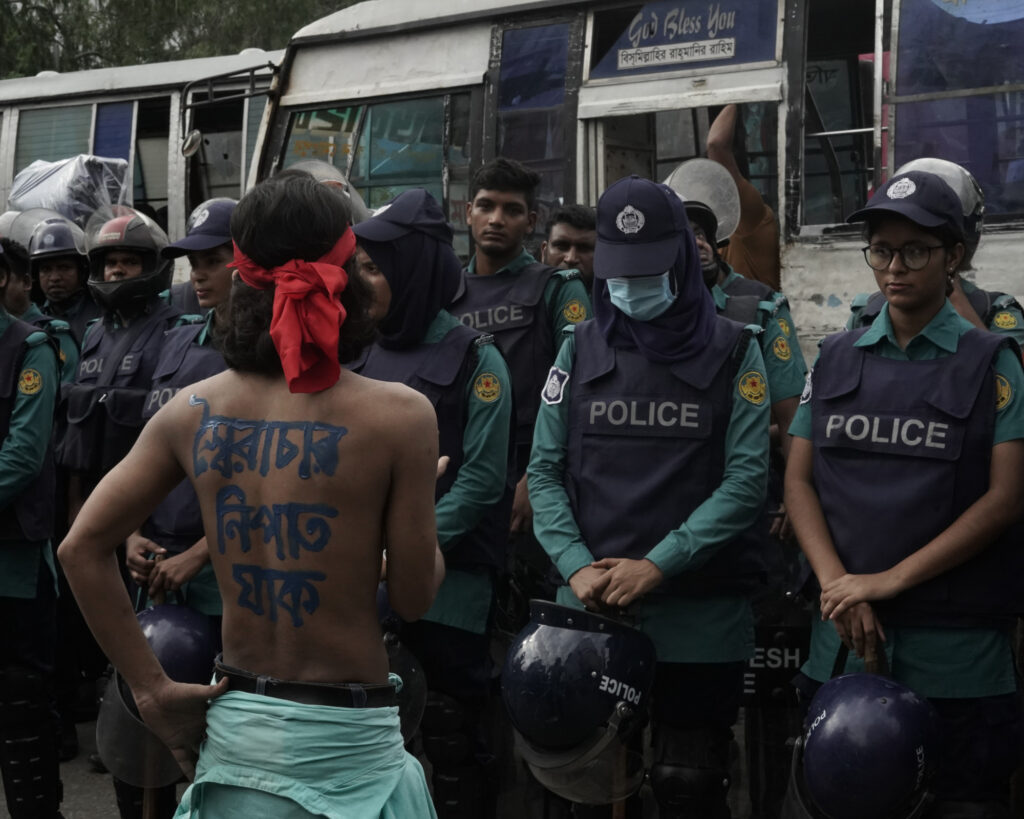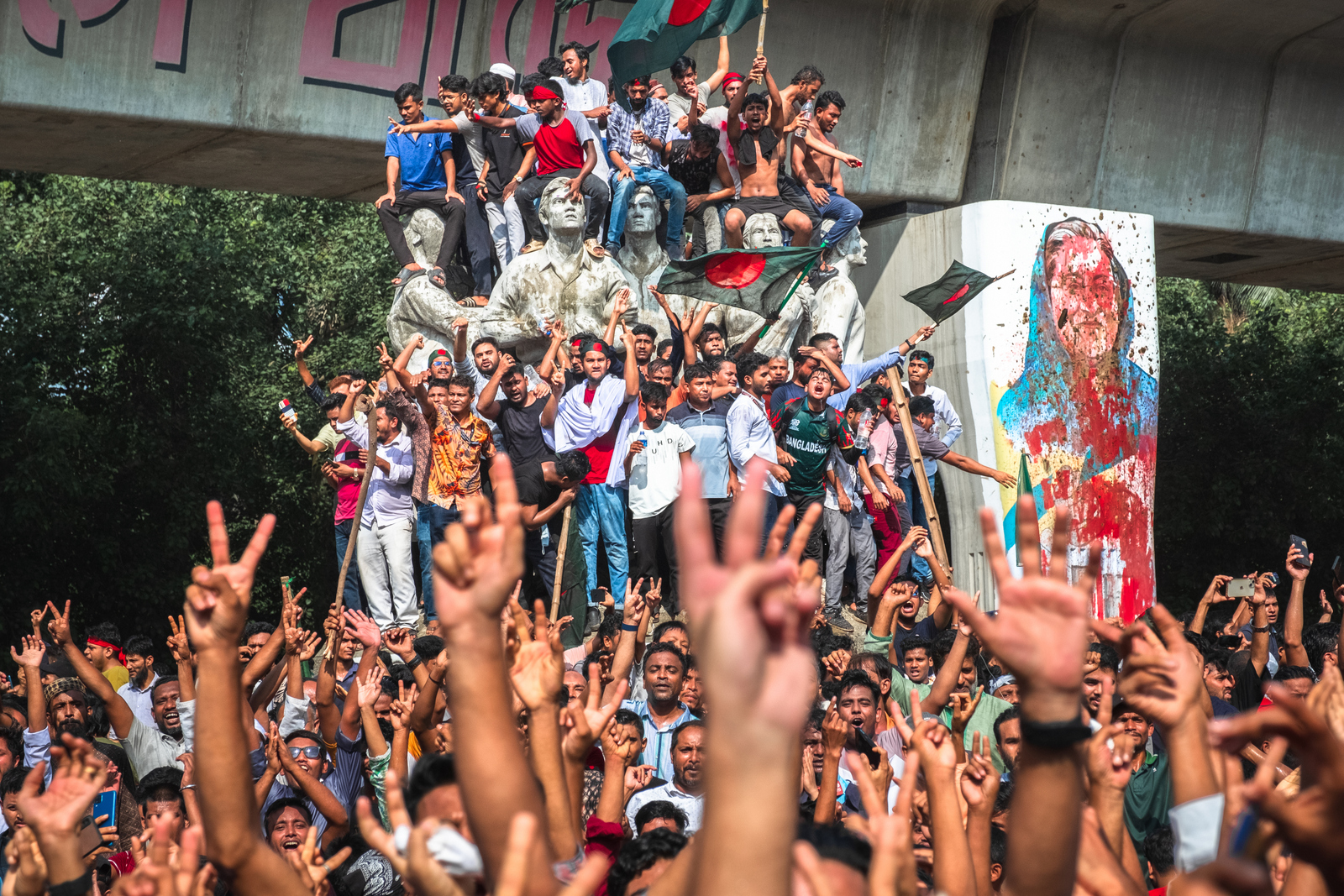This post is Part One of “The Bangladesh Chapter” of the b2o review’s “The University in Turmoil: Global Perspectives” dossier.
The July Movement of 2024
Naveeda Khan, Bareesh Hasan Chowdhury, and Shrobona Shafique Dipti
Raised on stories of the rebellious 1960s, we are aware of the large role played by students across the world protesting war, racial inequities, and human rights violations, among other issues. We are also well versed in the stories of reaction that set in soon afterwards, as police and armies beat back students, conservative governments came to power, and free-market ideology became dominant nearly everywhere. What, then, would it mean to encounter student protests in the present without this past determining its reception? How should we think about protests in parts of the world other than those which have been endowed with the capacity for historical change? Can we take our learning from emergent events whose trajectory we cannot claim to know in advance?
In “The Bangladesh Chapter” of “The University in Turmoil”, we explore what the country’s student-led July Movement of 2024 has to teach us in terms of the contours of student demands, the nature of student organizing, the spatial conditions of possibility for protests, and the narrative battle over the past in order to secure a different future. From the outset we do not claim the movement to be a success or even that it has been liberatory; we will, rather, follow its grain to arrive at a dense emplotment of what it is to struggle for meaning and political salience from within universities in our present. We begin with an account of the July Movement to contextualize our contributions to this chapter.

Starting in June 2024, students at the University of Dhaka, the eminent public university established in 1921, gathered in Shahbag, an area in the capital city well known for hosting protests. They demanded what seemed like an oddly specific thing. They wanted the reform of a quota system for lucrative government jobs that held a large quota (some 30%) for the children and grandchildren of those who had fought in the liberation struggle of 1971, which had secured Bangladesh’s independence from Pakistan. This quota for freedom fighters and their families had been reduced once already in the face of strong student protests in 2018, when it was brought down from 56% to 30%. The students’ request in 2024 to get rid of quotas entirely, including those for women, seemed specific and retrograde to boot. Intellectuals and ordinary people alike watched the protests from afar, uncertain as to whether it ought to matter to them or not.
A series of discursive missteps by then Prime Minister Sheikh Hasina soon made clear that the protests turned on more than policy, that she herself was a problem, particularly her personalistic and paranoid mode of running the country. Hasina was the child of an assassinated politician, the very same one generally credited with liberating the nation from Pakistan. Almost her entire family, barring her sister, was assassinated in 1975. Her framing of the protests exposed her Manichean view of the world, divided between those who were with her and those against her. And the students who protested a quota system that favored those who fought in the liberation struggle alongside her father were clearly not with her. Despite putatively accepting their demands, her hostility to the students was made apparent by the escalating attacks on them, first by the student wing of the Awami League, the ruling party, then by law-enforcement personnel, and finally to an extent by the military, alongside a campaign of disinformation and an unprecedented internet and communications blackout. Joined by their peers from other educational institutions, notably both public and private, the students took to the streets with bricks, sticks and rods to engage in street battles with state forces. Those from the working class soon joined the fray.
Many expected the government to dig in and massacre as many as required to hold onto power, but this was averted when the army chief of staff, who, reading the unrest in the streets and among rank-and-file soldiers, forced Sheikh Hasina to leave the country. It was a testimony to the hold that Hasina had over her party that her resignation couldn’t be salved by placing a more conciliatory member of the party as the interim head of the government. Her removal from the scene meant the collapse and universal discrediting of the Awami League party.
Even as students most publicly associated with what has come to be called the July Movement or July Uprising negotiated over the composition of the interim government with army officials and members of the opposition parties, long ill-treated by Hasina, they–the students–made clear that this government was not to assume the usual caretaker role of calling elections to usher in a new administration. Rather, the interim government was to reform the existing political system such that fascibad or fascism may never again triumph. Representatives of the students who organized the movement took up seats of government to ensure this, while others took to the streets first to uphold order in the immediate aftermath of the fall of the government, then to keep pressure on the interim government not to cave to reconciliation with the prior ruling party or other parties but to stay the course of reform.
What is meant by reform, however, and how it is to be brought about are still being deliberated some six months after the fall of the Awami League government. In that time the usual ageist, gerontological reaction to the utpat or mischief of the young has set in, particularly among the intelligentsia of the elite, and even some of the working class who strongly supported the students. And the students, those in government and those on the street, seem uncertain of the way forward. Recently, a large crowd of primarily young men demolished Hasina’s father’s house in Dhaka, once memorialized as a museum, out of a desire to be done with the past. Their past is of tyranny and trauma, and not of the progress recently preached by Hasina in an online address to her followers.
It is from within this present that we think it important to return to the July Movement, not to memorialize it, but to ask: what were the unique features of this movement that laid the foundations for its efficacy? And just how efficacious has it been? Is that efficacy faltering? The moment is complex. There are as many answers as there are questions.
Naveeda Khan is professor of anthropology at Johns Hopkins University. She has worked on religious violence and everyday life in urban Pakistan. Her more recent work is on riverine lives in Bangladesh and UN-led global climate negotiations. Her field dispatches from Dhaka in the middle of the July Uprising may be found here.
Bareesh Hasan Chowdhury is a campaigner working for the Bangladesh Environmental Lawyers Association on climate, policy, renewable energy and human rights.
Shrobona Shafique Dipti, a graduate of the University of Dhaka, is an urban anthropologist and lecturer at the University of Liberal Arts Bangladesh with an interest in environmental humanities and multi-species entanglements.

Leave a Reply